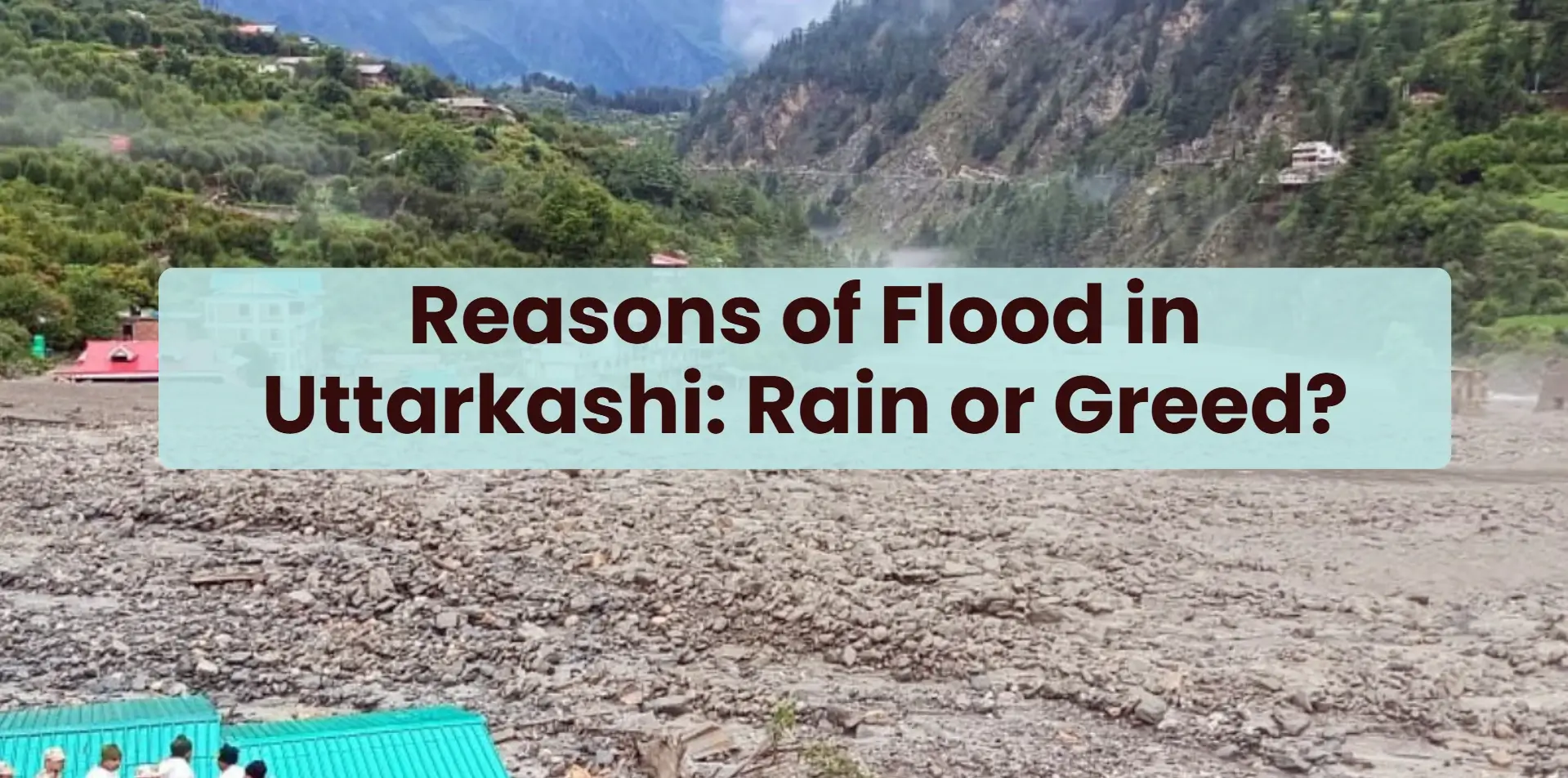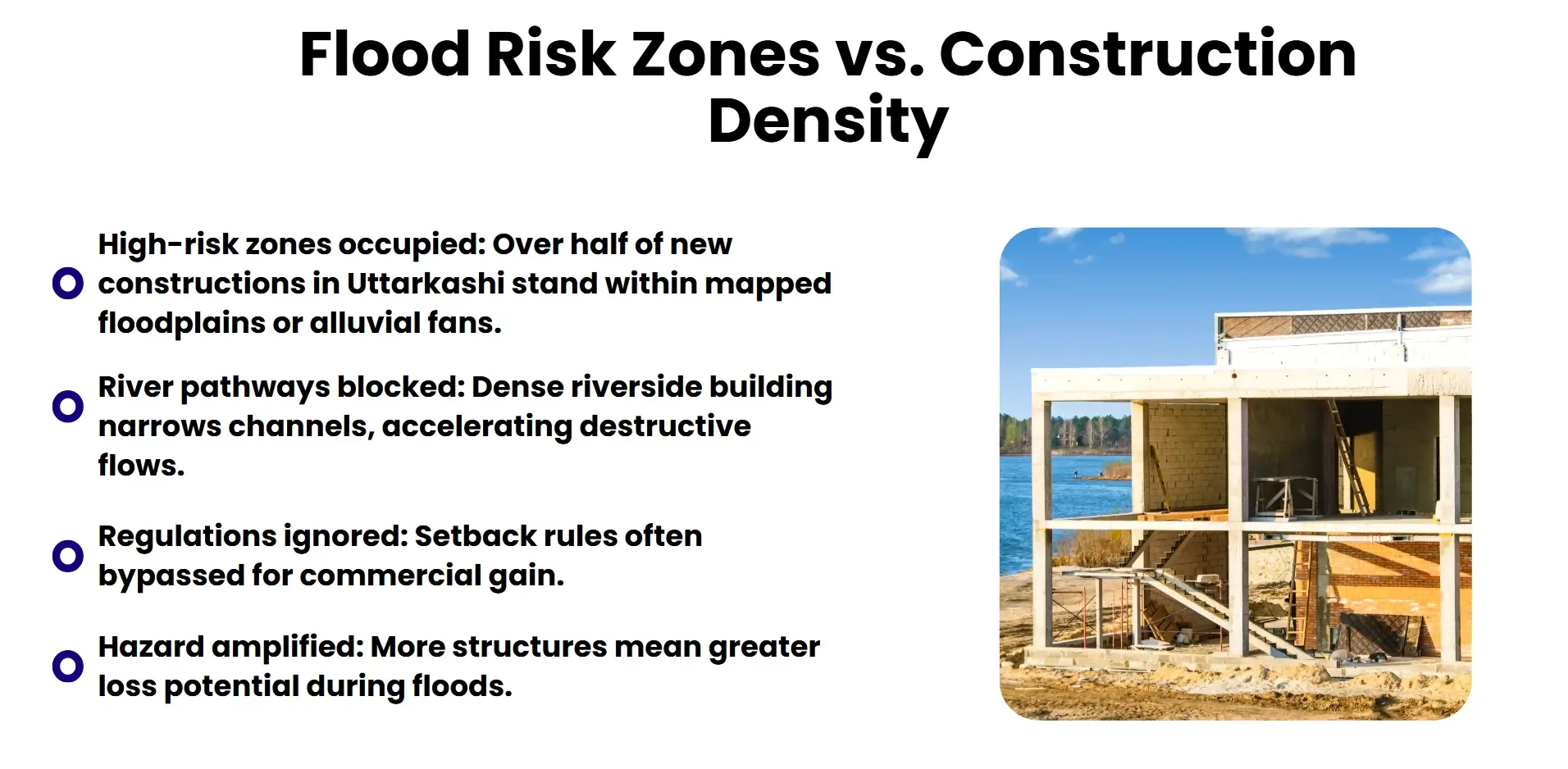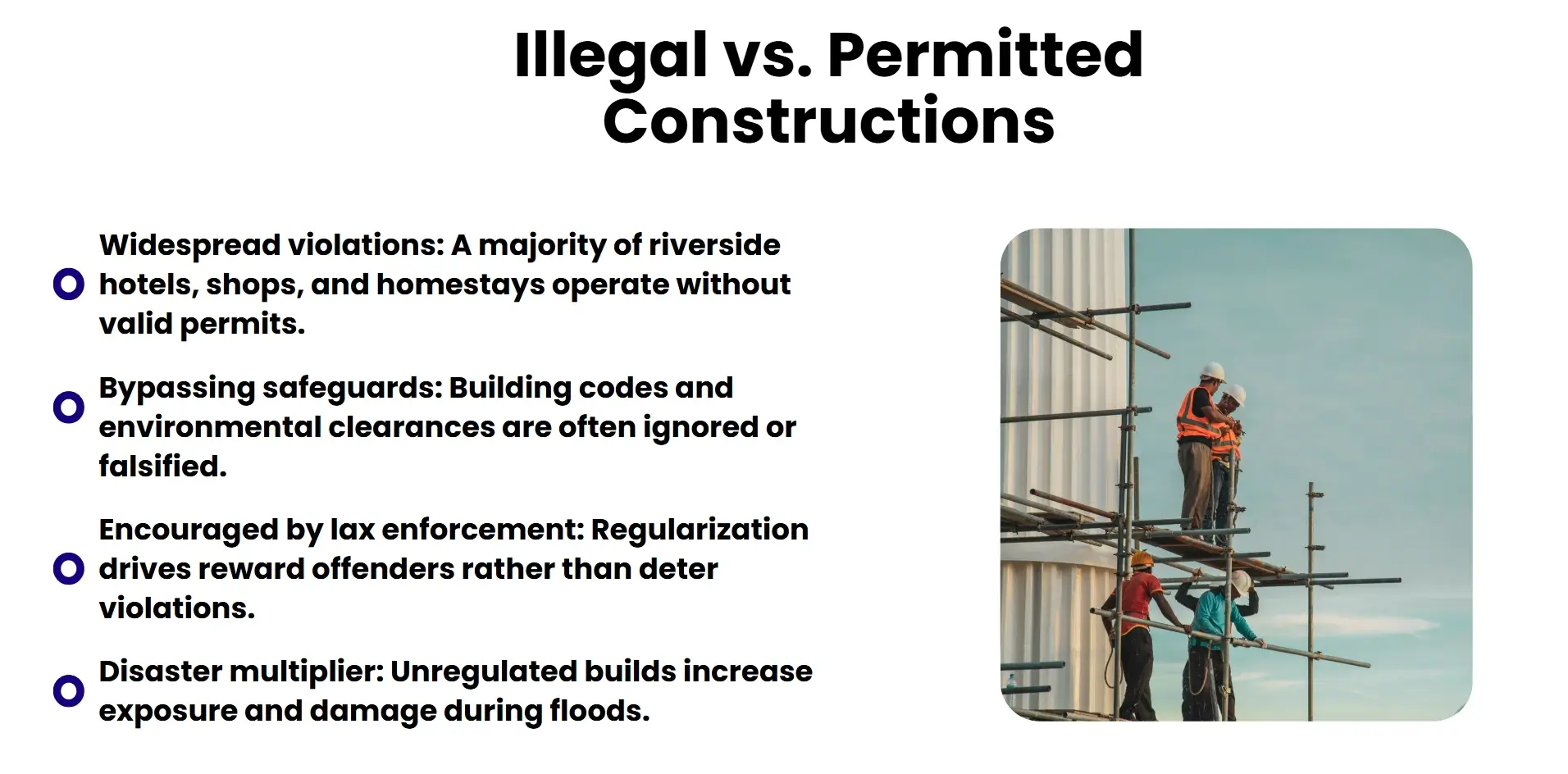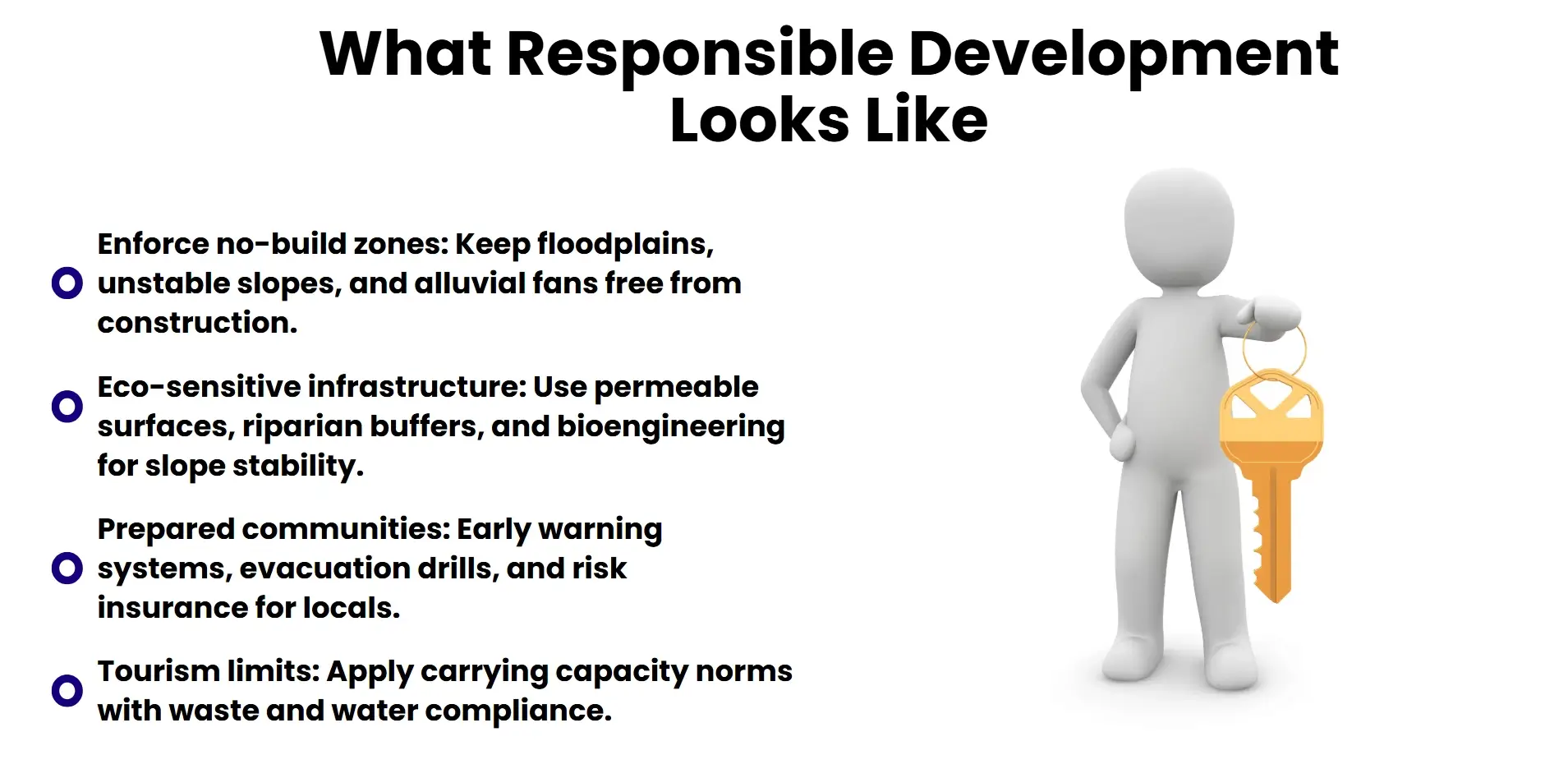The recent flash floods in Uttarkashi appear to be a result of a combination of heavy rainfall and human activities, rather than solely due to either "rain" or "greed".Climate change is increasing rainfall variability, but what contributes to a disaster of heavy rain in Uttarkashi is anthropogenic exposure and vulnerability-unregulated building in flood plains, encroachment on river beds, and the inability to avoid it.

Year by year, the Himalayas are reminding us about the power it has during the monsoon. But what happened in Uttarkashi was not merely a display of din caused by nature; it was also a human-made tragedy. Although global warming has enhanced rainfall patterns, the true catastrophe is that we have constructed over floodplains, cut out roads in unstable slopes, and left uncontrolled construction to thrive in areas with flash floods. There are guesthouses, ashrams and Maggi stalls now almost in the path of the river, quite often without planning and permits, quite often on military camps too.This article is in defiance of the refrain in regards to blaming climate alone. It suggests that the real villain of the destruction is greed in the form of illegal development, ineffective governing, and carelessness to ecological boundaries. It is made visible by looking at the hydrology of the region, failures of the institutions and actually lived experiences of the locals that risk has not been inherited but manufactured. What are the causes of rainfall floods? It occurs when drainage channels are filled and the rivers and streams can no longer accommodate the excessive water generated by severe weather conditions. Floods in Uttarkashi were inevitable and not something out of the blue. And until we face the structural causes of exposure, the Himalaya will only further reward our myopia. This is not only a rain story, but one of accountability.
Prologue: A night in Uttarkashi
The evening started in a very peculiar silence at Uttarkashi. The natives had a premonition that all was not well the roar of the Bhagirathi had been changed. The power wavered and went out and leaving the valley in blackness. The rain had been falling for hours past, but it was now pouring down in sheets and beating on the housetops and filling the drains. A grocer by the riverbank stood helplessly as water flowed around his closed shop, sweeping plastic chairs used in a roadside Maggi point which had been opened a couple of weeks back. But the river, which had become swollen and furious, no longer ran in its normal bed;it jumped embankments, tore through walls it had built retaining walls centuries before, and took back routes which it had long lost. Guesthouses that stood on precarious slopes were flickering out like detonating lights as they collapsed. It was not merely nature driving its way in at that time; it was a reckoning. The rain did not pick a path of destruction; however, it just continued in its path of negligence, greed, and disregardfor the warnings that were imprinted in the bones of the valley.

The Himalayan monsoon is ancient, the disaster recent
The Himalayan Monsoon has a long history of defining life in the mountains and has provided both life-giving harvest and peril. The size of the disasters and their frequency today indicate something not so historic and highly preventable.
An Extreme Landscape
Himalaya isa young, tender mountain system with a geologically active land that is prone to landslides, erosion, and sudden river shifts. The hills easily funnel precipitation into the steep, narrow valleys that carry off rainfall in a rush of runoff. Flash floods, cloudbursts, and debris flows were not unusual to the region- they are the hydrological nature of the area. In previous times, communities resiliently developed new homes by using locally available materials, moving to ground above river floods and respecting flood courses.
Climate Change as Multiplier
Global warming is the major cause of the increasing rainfall, and it has caused the multiplier effect on the increasing water in the streams. Higher temperatures cause warmer temperatures carrying more moisture,definitely resulting in heavier rainfall within a short period of time. Research indicates that there are increased instances of extreme rainfall events on a Himalaya scale, leading to the increased chances of flash floods and slope failures. However, it is not only about climate change,but also about risksbeing enhanced.
Manufactured Vulnerability
The novelty is that human action has aggravated risk. The cutting of roads without drainage, the construction of hotels on the riverbeds and the cutting of forests have rendered the landscape the natural ability to bounce back. The calamity is not only the rain; it is the expanding irresponsibly into areas that are prone to flooding. The Risk is not a born product of nature but a created issue of negligence and greed.
Greed on the flood path
It was during the monsoons and rain is not a disaster here in the Himalayas, same as can happen anytime; it is the decades of irresponsible construction, disregarding warnings and the need to seek profit that turned the Uttarkashi monsoon into a disaster.

Intruding the Waters of the River
Hotels, guest houses, and roadside restaurants in Dharali village, Uttarkashi, were constructed right on floodplains,the areas traditionally identified as prone to river surges. The constructions in these structures reduced the natural direction of the Bhagirathi, which compelled the river to speed up and scour the banks with increased intensity. Protective walls, the retaining walls, usually distribute water in unpredictable ways, leading to further destruction down the river. The river had not changed its course-it had taken it back.
Drainless Roads and anchorless slopes
Improper slope stabilization and drainage plans were not made on highways and pilgrimage routes that were widened. Ravines and rivers would be clogged with muck created by hill-cutting, dumped into them. When violent rains hit the ground, this trash was transformed into lethal slurry, which washed through villages. Problems included destabilization of slopes through hydropower tunnels and blasting, culverts and drains that were designed too small or were blocked and collapsed when required to help.
Regulatory Blindness and Tourist Pressure
The boom of pilgrimage and tourism boom saw an upsurge in informal construction of Maggi points, ashrams and homestays which were constructed without any clearance on the environment. Even the Bhagirathi Eco Sensitive Zone (BESZ) set up to control the development was habitually flouted. Residents of the area had complained to the government about unauthorized constructions and cutting down of the slope, but their cries fell on deaf ears. Zonal Master Plan prohibits building in a 100-meter radius of the midpoint of the river, but there tendencies of were many violations.
Ecological Protection StrippedAway
Forests that take up rain and hold the ground in place were being axed to build roads and resorts. Concrete replaced riparian vegetation, which was used to cushion floods. These natural barrier mechanisms were lost and heavy rainwater became a deadly phenomenon. The landscape, which was initially very strong, was made to become brittle due to the unrestricted ambitions.
Institutions that looked away
The Uttarkashi floods not only revealed the vulnerability of the ecology but also institutional collapse. The mismanagement of planning, delay in rescue following lapses paved the way for governance failures in transforming the hazard into a tragedy during the disaster.
Planning without Protection
Uttarkashi does not have a strong, enforced master plan even though the area lies in a high seismic and flood-prone zone. There are hazard zonation maps, but they seldom form part of land-use approvals. Without much control, construction is going on in the flood vulnerable zone and environmental impact assessments (EIAs) are being avoided or pieced together. There are new Bhagirathi Eco Sensitive Zone regulations to restrict development,but with poor enforcement, defaults are regularly regularized.
Delayed Rescue and Wrong Priorities
Upon the occurrence of a flash flood at Dharali, rescue work was tardy and inequitable. According to locals, tourists were evacuated first, leaving the residents trapped under rubble for hours. Obstructions on the roads and the uneven terrain were drawbacks to efforts, although the mismanagement and unpreparedness contributed to the crisis. Lack of such things as early warning systems and evacuation exercises meant that most people did not have time to respond. Reports have it that even journalists were not allowed to get access to the site and this is where questions of transparency arise.
Insurance and Recovery Gaps
In addition to the direct disaster, there is the presence of institutional neglect when it comes to recovery mechanisms. Particularly, in Uttarkashi, only a few of the households possess home insurance, as a result of which families become impoverished. Relief is most often ad hoc and relies on government assistance and charity, and there is no established risk transfer mechanism.
Case File: What really went on in Uttarkashi
The flash flood that hit the Dharali Village of Uttarkashi on August 5 was not just a show; it was an avoidable human disaster, influencedby terrain, rains, and human interference.
A chronology of the Tragedy
Several days of heavy rain prior to the flood had saturated slopes and loosened debris. Another excess of water (probably caused by a reawakened landslide or a glacial lake outburst flood) discharged a downpour of water, rocks, and mud. In a few minutes, houses, stores, and even a temple on the bank of a river were gulped up. Bhagirathi River, not being able to stay in its constricted canal, restored its earlier route, crushing anything that was in its path.
Terrain and Tampering
ISRO satellite imagingDharali sat on an alluvial fan, which is a cone-like stockpile of previously flooded sediment. This was not a stable formation to be built on. But now business had reached right in on it, and so confined the course of the river that the flood had become far more powerful than before. Scientists have cautioned that this geomorphic change may initiate long-term downstream erosion.
Rescue and Fallout
The rescue services were hindered by closed roads and unstable land. Locals claim that tourists came first when evacuating people, as 200 people were evacuated. Officially, there are 4 deaths, but people who witnessed the event think that more than 100 people are missing, with some of them buried under 8 to 25 feet of rubble. There is a new threat of yet another rupture downstream as a temporary lake has formed upstream, and the India Meteorological Department has predicted the heavy rainfall to continue.
What a Responsible Himalaya will be like
The Himalaya does not have to be tamed but should be respected. Serious thinking combines bio-intelligence, durable infrastructure, and administration that believes in security more than instantaneous gains.

Nature-basedplanning and not against nature
Alluvial fans, flood plains, and landslide-prone slopes should be excluded as categorical no-build zones. The maps of hazard zoning and placement of setbacks against rivers and unstable topography should be incorporated into master plans. Hill-specific codes must be followed on construction, and plinth heights, slope anchoring and seismic safety must be designed into the construction, not as a convenience option.
Breathing Infrastructure
Proper drainage, bench cutting, and debris traps should be designed in roads. Projects that demand hydropower have to undergo cumulative impact analyses, and not some orders done one by one. The flood energy must be absorbed by repairing the riparian buffers that consist of vegetated zones along the rivers. Concrete walls can be replaced with bioengineering and permeable surfaces that minimize runoff and erosion.
Risk Management Oriented to the Community
The last mile now means the implementation of early warning systems down to the last mile in the form of sirens, SMS alerts, and evacuation drillsissued seasonally. Micro-insurance and disaster pools are some of the risk transfer tools capable of safeguarding livelihoods. Carrying capacity norms to regulate tourism should be partly related to the issuance of licenses expressed in terms of waste, water, and safety compliance.
Politics That Protects
There has to be accountability among the institutionsthatrequire coordination of the various departments, forest, irrigation, tourism, and disaster management. Penalizing should be done for violating and not extending regulations. Willingness to be transparent in authorisation, supervision, and responding to disasters brings trust and resiliency.
Conclusion
The flash flooding in Uttarkashi was no accident; it was the result of careless disregard that followed short-term thinking and greed. Whether the rainfall has become excessive due to climate change or humanity is another debate in itself, but it is the human choices that directly put lives and livelihoods in front of danger. It is clear that when rivers are widened, slopes eroded, and flood plains occupied, then disaster will be inherent. The tragedy should act as a wake-up call not only to Uttarkashi but also to all of the Himalayan towns that desire an unconstrained path towards development. Resilience can no longer be an afterthought and should be fully integrated into all roads, permits and policies. It is not enough to remember this flood: we should put into practice what it teaches.